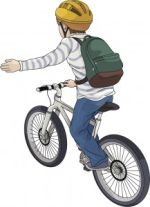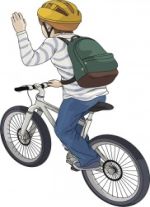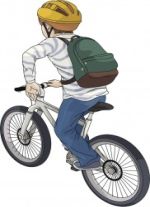You have probably heard this old line many times:
It's just like riding a bicycle, once you learn, you never forget.
Muscle memory may keep us upright on our bicycles no matter how long it's been, but as a cyclist it is a good idea to frequently brush up on cycling safety and signals to ensure you, and everyone else on the road, is safe during your next ride.
Choosing The Right Bike
Always ride a bike that is the appropriate size for your height and body type.
- When straddling a bike's crossbar while standing on the ground with flat feet, there should be one or two inches between you and the frame (or three inches for mountain bikes).
- Adjust the bike saddle so that when seated your heels can comfortably rest on the pedals. If you rock from side to side when pedaling backwards, your saddle is too high.
- Legs should not be fully extended when pedaling. With the balls of your feet on the pedal, your leg at the bottom of a stroke should extend about 95 per cent of way when at the bottom of a stroke.
- Handlebar grips should be about seat level. If your bike uses dropped handlebars, the upper portion should be at or slightly below seat level.
- By law in Ontario, bicycles must have a white front light and a red rear light/reflector to be operated between one-half hour before sunset and one-half hour after sunrise. White and red reflective strips are required on the front forks and rear stays, respectively. Finally, bikes must have a working bell or horn for use when passing.
- Inspect your bike before riding and make sure all parts are securely fastened and working.
Riding a bike that is not adjusted properly for your body greatly increases the risk of falls and collisions. Take the time before you drive to make sure it's a perfect fit.
Choosing The Right Gear
In addition to the bicycle itself, be sure to dress appropriately for your journey.
- While all cyclists in Ontario under the age of 18 must wear an approved helmet, we strongly recommend that every single rider should wear a helmet regardless of age or experience.
- Be sure to wear a helmet designed for cyclists and not one for other sports as they are specially tested to protect against different types of impact.
- For maximum protection, helmets should fit snugly, square and level on your head.
- Bright or reflective clothing should be worn while driving, especially during times of the day when visibility is reduced.
If you are clearly visible to other drivers, you reduce your risk of collisions.
Know Your Hand Signals
Unlike motor vehicles, bicycles don't have blinkers and brake lights to indicate when a driver plans to make a turn, is slowing down, or makes a sudden stop. Instead, cyclists should use hand signals to alert surrounding traffic to their actions.
- Signal at least 100 feet before a turn.
- Stay in control of the bicycle by keeping both hands on the handlebars as you are making any turn.
LEFT TURN
- To turn left, extend your left arm
horizontally to the side of the bicycle.

RIGHT TURN
- To turn right, extend your left arm
out horizontally with your hand and forearm raised upward.
Alternatively, you can extend your right arm our horizontally to
the side of the bicycle.

STOPPING
- For sudden stops or when slowing
down, extend your left arm out horizontally and your hand and
forearm downward.

If other drivers can anticipate your path, everyone will be safer for it.
We are both avid cyclists and participate in the yearly Ride to Conquer Cancer – a two-day cycling event spanning over 200 kilometres throughout Ontario's picturesque countryside. In our next blog post, we will cover safety tips for motor vehicle drivers who share the road with cyclists, including the basic hand signals used by avid cyclist to communicate with others on the road.
The content of this article is intended to provide a general guide to the subject matter. Specialist advice should be sought about your specific circumstances.


